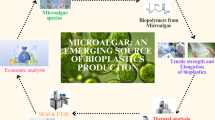Abstract
Biodiesel from microalgae is recognized as a desirable, renewable biofuel to replace petroleum-derived transport fuels. However, the efficient harvesting of microalgae is a major hurdle for commercialization. Therefore, the development of a cost-effective harvesting method is essential to reduce production cost. A partial factorial design was used to screen the main factors involved, which were the concentration of FeCl3, the bioflocculant, and the time of slow mixing. Response surface methodology (RSM) was used to further investigate the optimal conditions for these factors on flocculation of Botryococcus braunii. Analysis of variance and other relevant tests confirmed the validity of the suggested model. The optimal conditions inferred from the obtained equation were 0.79 mM FeCl3, 0.58 % (v/v) bioflocculant, and 180 sec of slow mixing for 1.1 g DCW L−1 of B. braunii. The flocculating activity under these conditions was 90.6 %. By using RSM, the optimal conditions for flocculation of B. braunii could be reached more quickly and efficiently.





Similar content being viewed by others
References
Banerjee A, Sharma R, Chisti Y, Banerjee UC (2002) Botryococcus braunii: a renewable source of hydrocarbons and other chemicals. Crit Rev Biotechnol 22:245–279
Chen X, Li Y, Du GC, Chen J (2005) Application of response surface methodology in medium optimization for spore production of Coniothyrium minitans in solid-state fermentation. World J Microbiol Biotechnol 21:593–599
Chisti Y (2007) Biodiesel from microalgae. Biotechnol Adv 25:294–306
He N, Li Y, Chen J (2004) Production of a novel polygalacturonic acid bioflocculant REA-11 by Corynebacterium glutamicum. Bioresour Technol 94:99–105
Jeong GT, Park DH (2006) Response surface methodological approach for optimization of enzymatic synthesis of sorbitan methacrylate. Enzyme Microbiol Technol 39:381–386
Lhomme B, Roux JC (1991) Utilization of experimental designs for optimization of Rhizopus arrhizus culture. Bioresour Technol 35:301–312
Li Z, Zhong S, Lei HY, Chen RW, Yu Q, Li HL (2009) Production of a novel bioflocculant by Bacillus licheniformis X14 and its application to low temperature drinking water treatment. Bioresour Technol 100:3650–3656
Mandal S, Mallick N (2009) Microalga Scenedesmus obliquus as a potential source for biodiesel production. Appl Microbiol Biotechnol 84:281–291
Molina Grima E, Belarbi EH, Acien Fernandez FG, Robles Medina A, Chisti Y (2003) Recovery of microalgal biomass and metabolites: process options and economics. Biotechnol Adv 20:491–515
Oh H-M, Lee SJ, Park M-H, Kim H-S, Kim H-C, Yoon J-H, Kwon G-S, Yoon B-D (2001) Harvesting of Chlorella vulgaris using a bioflocculant from Paenibacillus sp. AM49. Biotechnol Lett 23:1229–1234
Salehizadeh H, Vossoughi M, Alemzadeh I (2000) Some investigations on bioflocculant-producing bacteria. Biochem Eng J 5:39–44
Wu JY, Ye HF (2007) Characterization and flocculating properties of an extracellular biopolymer produced from a Bacillus subtilis DYU1 isolate. Process Biochem 42:1114–1123
Yang ZH, Huang J, Zeng GM, Ruan M, Zhou CS, Li L, Rong ZG (2009) Optimization of flocculation conditions for kaolin suspension using the composite flocculant of MBFGA1 and PAC by response surface methodology. Bioresour Technol 100:4233–4239
Yoo C, Jun S-Y, Lee J-Y, Ahn C-Y, Oh H-M (2010) Selection of microalgae for lipid production under high levels carbon dioxide. Bioresour Technol 101:S71–74
Acknowledgments
This research was supported by the Advanced Biomass R&D Center (ABC) funded by the Korean Ministry of Education, Science & Technology (ABC-2010-0029723) and by a grant from the Carbon Dioxide Reduction & Sequestration Research Center, a 21st Century Frontier Program funded by the Korean Ministry of Education, Science & Technology.
Author information
Authors and Affiliations
Corresponding author
Rights and permissions
About this article
Cite this article
Kim, DG., Oh, HM., Park, YH. et al. Optimization of flocculation conditions for Botryococcus braunii using response surface methodology. J Appl Phycol 25, 875–882 (2013). https://doi.org/10.1007/s10811-012-9948-4
Received:
Revised:
Accepted:
Published:
Issue Date:
DOI: https://doi.org/10.1007/s10811-012-9948-4




